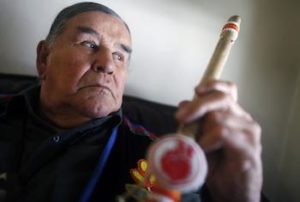
Clyde Bellecourt
*Clyde Bellecourt was born on this date in 1936. He was an Ojibwe Native American Civil Rights organizer.
Clyde Howard Bellecourt was the seventh of 12 children born to Charles and Angeline. Bellecourt was on the White Earth Indian Reservation in northern Minnesota. Among his older siblings was his brother Vernon Bellecourt. White Earth was considered the most significant and poorest of north Minnesota's Ojibwe communities. Bellecourt pushed back against authorities in his youth, believing they did not treat his family and other indigenous people respectfully.
As a child, he could hear his parents speaking in low tones late at night in a language he did not understand. When he asked what they were saying, they told him to think about his education and do as well as possible. His years in school were not pleasant. As a boy, he attended a reservation white Catholic mission school run by strict nuns of the Benedictine order. The Bellecourt family moved to Minneapolis, in the Twin Cities, in the 1950s, encouraged by the federal government to seek a setting where there might be more job opportunities.
They found the city complex, and Bellecourt reacted to perceived discrimination and felt out of place; he regularly received detentions at school. Getting involved with urban street crime, Bellecourt was arrested. He was convicted and sentenced to the adult prison at St. Cloud for burglary. At 25, Bellecourt served the remainder of his sentence at Stillwater Prison in southern Minnesota. There, he met other Native Americans, many of whom were also from Ojibwe.
Dennis Banks, Eddie Benton-Banai, and George Mitchell started a cultural program for Native Americans at the prison. While incarcerated, both men contemplated their pasts and Indian heritage to arrive at new visions of Indian politics that could deliver liberation outside the scope of assimilated respectability. After working together in prison, they created a similar program in Minneapolis to aid urban Indians. This evolved into the American Indian Movement (AIM) in Minneapolis, Minnesota, in July 1968. His older brother, Vernon Bellecourt, was also active.
This stance embodied AIM's actions and directly connected them to the Black Power and antiwar movements, whose efforts to reimagine American society were coming to a head. Under Bellecourt's leadership, AIM raised awareness of tribal issues related to the federal government. They monitored police harassment in Minneapolis, created welfare programs for urban Indians, and founded Indian survival schools in the Twin Cities to teach children life skills and help them learn their traditional cultures.

He initiated the Trail of Broken Treaties, a march to Washington, DC, in 1972 to serve as a first step to renegotiating federal-tribal nations' treaties and relations. In addition, he founded non-profit groups to undertake economic development to benefit Native Americans. Bellecourt drew international attention in February 1973 for his role in leading Native American people to Wounded Knee in an armed takeover of the South Dakota town on the Pine Ridge reservation, the site of the 1890 massacre of Lakota men, women, and children.
The 71-day siege inspired all indigenous people, though it did not bring about the immediate reforms sought by AIM activists. However, it succeeded in bringing attention to the plight of Native Americans. The Black Panthers became an inspiration and a model for some Native American activists and the American Indian Movement (AIM), which led the most visible resistance campaigns in the 1970s. However, like the American Civil Rights movement for Blacks, Native American activism began earlier.
In the 1940s, federal and state legislatures began pursuing a policy of termination, which no longer recognized tribal governments, suspended government aid, privatized Native lands and resources previously held in common, and compelled Indians to assimilate into mainstream American cultural and economic practices. In response, in 1944, Indians from across the country formed the National Congress of American Indians (NCAI), departing from organizing that had previously occurred almost exclusively along the lines of tribe and treaty.
As a legislative advocacy group, the NCAI played an instrumental role in eventually ending termination and protecting Native rights and cultures by helping secure the passage of laws like the 1975 Indian Self-Determination and Education Act, the 1968 Indian Civil Rights Act, and the 1978 American Indian Religious Freedom Act. He understood the connections between Native Americans and African Americans. Clyde Bellecourt, whose Ojibwe name is Nee-gon-we-way-we-dun, which means "Thunder Before the Storm," died of cancer on January 11, 2022.